Recovering a Soling 1M
The Capital Area Model Boat Association CAMBA purchased this tug with a motor upgrade kit to serve as a buoy tender and recovery vessel for the club. Christened the URGER, it is shown here escorting a One Meter Soling. Ted S. reports that the Urger has been able to handle the much larger Solings. Photos of their "dumper" towed by the tug to place buoys will follow. CAMBA is located in the Albany - Schenectady area of New York State.
________________________________________
We ( <http://www.chicagorcsailing.org/> http://www.chicagoRCsailing.org) have been using the Vac-U-Tug as a club utility boat for 2 seasons now. Mark setting and recovery of ten pound Soling One Meters, sometimes two tangled together. (Don't put your cleats on the side of your booms.)
We've tried catching boats with a hook on the side and with a
lightweight U
shape ahead of the tug (as described in the message I'm responding to). By
far the best solution we've found is neither of these. Catching boats on the
side works in many situations, but is slow and needs precision. Hard to see
that well 50 or 100 feet away. The U ahead of the boat really slows things
down, and its windage and water drag can make the tug hard to control.
The power of the tug just doesn't compare with a human arm's strength and
sensitivity for pulling things back, so we use two systems:
The usual, our basic: As soon as we are done using the tug to set marks we
attach a long line by a carabiner at one end to the tow point at the center
of the back deck. The remainder stays on the spool until we need it. The 250
foot line was about 50 feet too short one time last year, so we've moved up
to 500 ft. Also another attachment point further aft might help keep the tug
in a more stable position.
For a recovery, one person drives the tug out while another feeds line. The
tug then circles the boat(s) in trouble, trying to stay about 3-5 feet away.
This could be two tangled boats, a dismasted boat, etc. Stay clear of
debris/mast/sails as we had a telltale foul our prop once. After a circle or
two, start pulling the line back in. The tug will almost certainly get drawn
into the mess, but usually won't slip back around. Slowly pull the whole
mess back to shore.
In a few situations, circling the boats may be difficult: if they are in
weeds, against a wall, &c. In those cases, we have a reverse hook extending
out from the tug on either side, about even with the front of the deck
house. (It's just a bent coat hanger attached to stainless screws mounted
into the rail and epoxy backing.) It extends out about 4 or 6 inches and
back by a little more than that. To recover a boat like this, again use the
long line attached to the tug but this time just nestle upside the boat to
be recovered and snag a stay or sheet.
Neither of these will work on a dismasted boat in the weeds, maybe that's
what wading is for. Jamie F.
_________________________
Big 10 pound sailboat. This tug is equipped with the Power Upgrade for Vac-U-Tug Jr, for 10 ounces of static pull. It is able to wrestle the Soling home, but some skill is necessary. Photos and commentary by James F. in Chicago.
Another method is to use the tug to pull the end of a 500' spool of heavy nylon string from the hardware store. Well... not from the hardware store, from the reel on the shore that your buddy is holding. It would take more than 500 feet if it were pulling from the hardware store. Not to mention the issue of traffic and the tripping hazard... Drive the tug out, run around the disabled boat or boats once or twice, use the reel to drag the whole mess back to shore. Hopefully, in the Spring, we'll have some photos to show more about this.
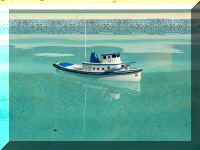
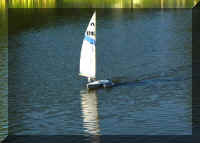
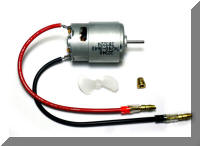
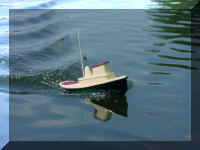
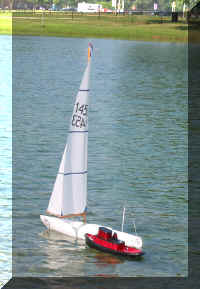
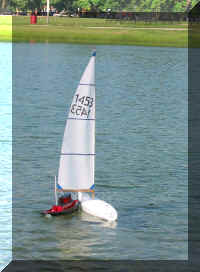

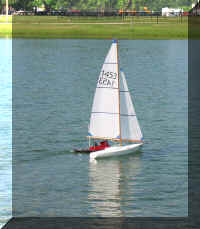
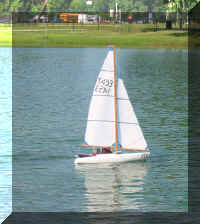
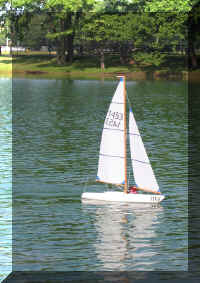
 TM
TM